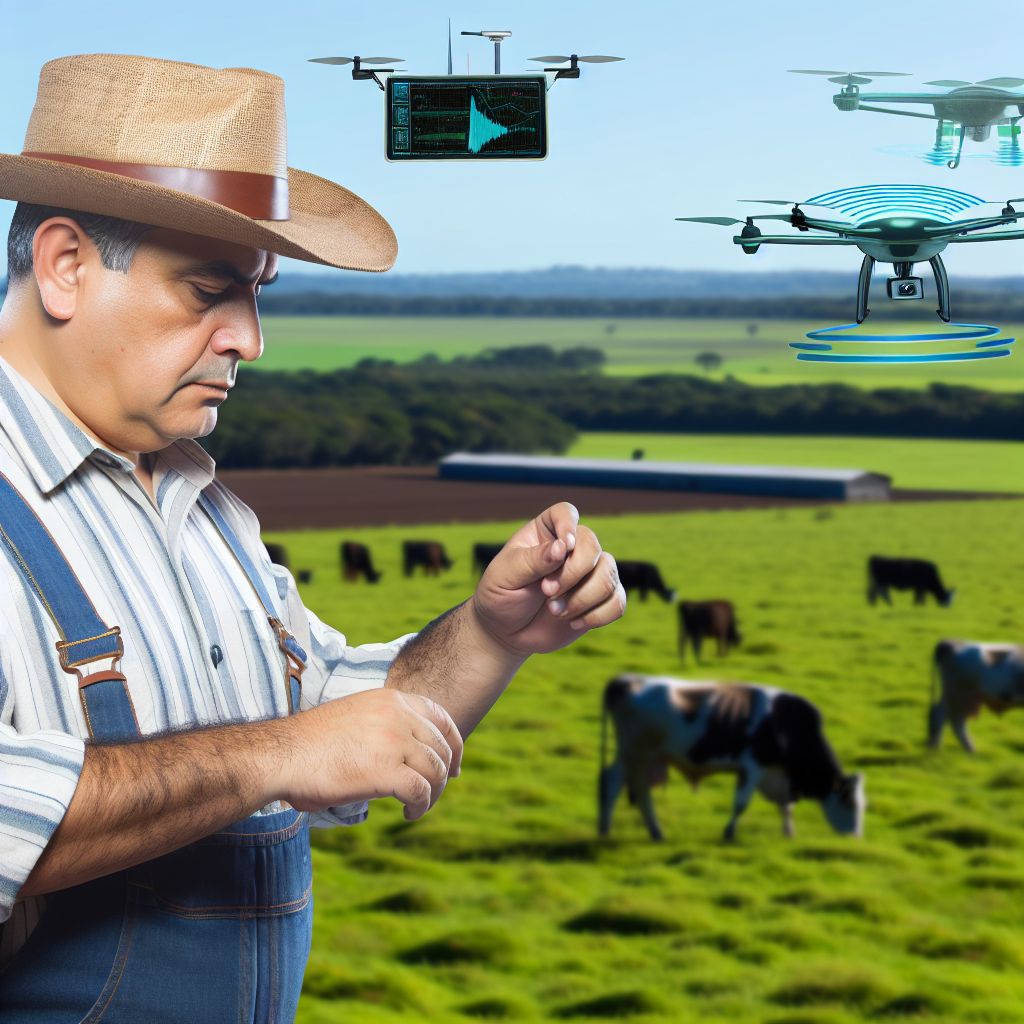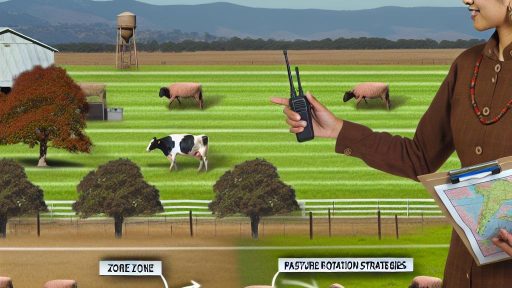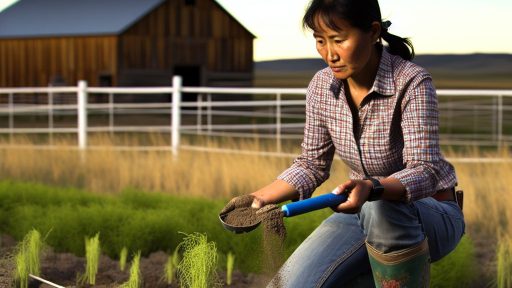Introduction to Remote Sensing in Livestock Farming
Defining Remote Sensing
Remote sensing involves collecting data from a distance.
Technologies like satellites and drones play a key role.
These tools gather information about livestock and their environment.
Thus, it enhances decision-making in farming practices.
Importance of Remote Sensing in Livestock Farming
Remote sensing allows farmers to monitor livestock health.
Additionally, it tracks feed consumption and grazing patterns.
This data helps optimize feeding strategies.
Consequently, farmers can improve overall livestock productivity.
Applications of Remote Sensing Technology
Farmers use remote sensing for multiple applications.
- Tracking animal movements across vast pastures.
- Monitoring environmental conditions affecting livestock.
- Identifying potential health issues before they escalate.
Each application aids in making informed decisions.
The Role of Data Analytics
Data collected through remote sensing needs analysis.
Analytics software transforms raw data into actionable insights.
This process allows farmers to predict trends in feed usage.
Ultimately, it improves feed management practices.
Challenges in Implementing Remote Sensing
While beneficial, remote sensing comes with challenges.
Transform Your Agribusiness
Unlock your farm's potential with expert advice tailored to your needs. Get actionable steps that drive real results.
Get StartedCosts for equipment and technology can be high.
Furthermore, data interpretation requires specific expertise.
Training for farmers ensures effective use of the technology.
Future Trends in Remote Sensing for Livestock Farming
The future of remote sensing looks promising.
Advancements in AI and machine learning enhance data analysis.
Moreover, improved sensors provide more accurate information.
As a result, precision livestock farming will evolve significantly.
The Role of Remote Sensing Technologies in Precision Agriculture
Introduction to Remote Sensing
Remote sensing encompasses various technologies that collect data from a distance.
This approach transforms how we monitor agricultural practices.
It uses satellite and aerial imagery to gather valuable information.
This data helps farmers make informed decisions for their livestock operations.
Enhancing Feed Management
Effective feed management is crucial for livestock productivity.
Remote sensing technologies allow farmers to monitor pasture conditions.
These conditions include soil moisture and vegetation health.
By understanding these factors, farmers can optimize feed resources.
Implementing Precision Livestock Farming
Precision livestock farming uses technology to enhance animal management.
Remote sensing plays a vital role in this innovative approach.
It assists in tracking animal behavior and health indicators.
Farmers can utilize this data to adjust feeding strategies accordingly.
Benefits of Remote Sensing in Livestock Farming
Remote sensing offers numerous benefits for livestock farmers.
- It increases operational efficiency by reducing manual labor.
- Farmers can make timely decisions based on real-time data.
- It promotes sustainable practices by minimizing waste.
- Farmers can better allocate resources, improving animal welfare.
Challenges and Considerations
Despite its advantages, remote sensing technology faces challenges.
Integration with existing farming systems may require investment.
Farmers must also ensure data quality and accuracy.
Understanding technology limitations is essential for successful implementation.
Showcase Your Farming Business
Publish your professional farming services profile on our blog for a one-time fee of $200 and reach a dedicated audience of farmers and agribusiness owners.
Publish Your ProfileLooking Ahead in Remote Sensing
The future of agriculture is increasingly driven by technology.
As remote sensing evolves, its applications will expand further.
Farmers must stay informed about emerging tools and techniques.
This knowledge will enable them to enhance their livestock management practices.
Current Technologies Used in Remote Sensing for Livestock Management
Satellite Imaging
Satellite imaging provides comprehensive views of grazing areas.
This technology helps in monitoring pasture conditions.
Farmers can assess the growth patterns of forage.
Consequently, they can manage feed allocation more effectively.
Additionally, satellite data allows for tracking livestock movements.
Drones and UAVs
Drones equipped with sensors have transformed livestock management.
They can cover vast areas quickly and efficiently.
This technology captures high-resolution images of herds.
Farmers use UAVs to spot health issues and diseases early.
Moreover, drones facilitate real-time monitoring of animal behavior.
Wearable Sensors
Wearable sensors provide valuable data on livestock health.
These devices monitor vital signs and activity levels.
Farmers receive alerts about abnormal conditions.
By wearing these sensors, animals contribute to improved welfare management.
As a result, this data enhances overall herd productivity.
Environmental Sensors
Environmental sensors measure conditions like humidity and temperature.
These metrics influence cattle health and feed intake.
By analyzing environmental factors, farmers can adjust management strategies.
This prevention helps avoid heat stress among livestock.
Consequently, it promotes better feed efficiency and sustainability.
Integration with Machine Learning
Integrating remote sensing data with machine learning enhances insights.
This combination allows for predictive analytics in livestock management.
Farmers can use algorithms to forecast feed requirements.
Moreover, they can optimize feeding schedules based on predictions.
The result is improved efficiency and reduced waste.
Explore Further: Sustainable Livestock Practices for Regenerative Agriculture
Benefits of Remote Sensing for Feed Management and Livestock Health
Enhancing Feed Efficiency
Remote sensing significantly enhances feed management efficiency.
It provides real-time data on pasture conditions.
This data helps farmers monitor forage availability effectively.
Consequently, livestock receive optimal nutrition tailored to their needs.
Better feed efficiency boosts livestock health and productivity.
Improving Livestock Monitoring
Remote sensing improves livestock monitoring capabilities.
Farmers can track animal movement and behavior from a distance.
This information reveals the health status of the herd promptly.
Additionally, it allows for timely interventions when needed.
As a result, livestock welfare and productivity increase.
Showcase Your Farming Business
Publish your professional farming services profile on our blog for a one-time fee of $200 and reach a dedicated audience of farmers and agribusiness owners.
Publish Your ProfileReducing Environmental Impact
Using remote sensing can significantly reduce environmental impact.
Farmers can manage resources more sustainably with accurate data.
Efficient feed management minimizes waste and overgrazing.
This practice helps maintain soil health and biodiversity.
By monitoring environmental changes, farmers can adapt quickly.
Cost Savings and Economic Benefits
Remote sensing leads to substantial cost savings for farmers.
It lowers feed expenses through precise management.
Farmers can identify underperforming areas and optimize inputs.
Moreover, improved livestock health reduces veterinary costs.
This approach enhances farm profitability in the long run.
Gain More Insights: Sustainable Livestock Practices for Minimizing Antibiotic Use
Case Studies of Remote Sensing Applications in Feed Optimization
Case Study: Smart Livestock Monitoring
In Maryland, farmers employed remote sensing technologies for livestock monitoring.
The system used drones with infrared cameras to assess cattle health.
Farmers detected temperature variations indicating stress or illness.
This proactive approach improved overall herd health and feed management.
As a result, the farmers reported reduced feed costs and higher productivity.
Case Study: Precision Feed Intake Measurements
In Australia, a beef ranch trialed remote sensing for precision feed intake monitoring.
They installed RFID tags on cattle for real-time tracking of feed consumption.
This data revealed individual animal needs and preferences.
By optimizing feed rations, they minimized waste and maximized growth rates.
Consequently, the ranch saw an increase in profit margins.
Case Study: Crop and Feed Resource Management
A study in Canada showed how remote sensing supports crop and feed resource management.
Farmers utilized satellite imagery to evaluate pasture health and growth rates.
This information allowed for tailored grazing plans based on pasture condition.
As a result, livestock had access to optimal grazing areas throughout the season.
The improved management led to healthier animals and reduced overgrazing.
Case Study: Integrated Climate Monitoring
In the Netherlands, farmers integrated climate monitoring with feed management.
They employed remote sensing to assess weather patterns affecting feed quality.
This data informed timely decisions on supplementary feeding strategies.
Ultimately, it ensured livestock received adequate nutrients regardless of climate challenges.
This practice helped sustain high levels of animal productivity.
See Related Content: How Proper Foot Care Can Prevent Lameness in Farm Animals

Challenges and Limitations of Implementing Remote Sensing in Livestock Farming
Technical Limitations
Remote sensing technology can face technical challenges.
Signal interference can disrupt data transmission.
Sensor calibration issues may lead to inaccurate readings.
Moreover, complex environments affect sensor effectiveness.
Data Management Challenges
Managing large volumes of data is often overwhelming.
Data processing can require significant computational resources.
Analyzing diverse datasets poses further difficulties.
Additionally, storing and retrieving data efficiently is essential.
Showcase Your Farming Business
Publish your professional farming services profile on our blog for a one-time fee of $200 and reach a dedicated audience of farmers and agribusiness owners.
Publish Your ProfileFinancial Constraints
Implementing remote sensing can be costly for farmers.
Initial setup costs for technology can be prohibitive.
Furthermore, ongoing maintenance expenses can add up.
Budget restrictions can limit adoption among small operations.
Skill Shortages
Farmers may lack training in remote sensing technologies.
Understanding complex data analysis requires specialized skills.
Moreover, ongoing education is essential for effective use.
Without proper knowledge, benefits of technology may go unrealized.
Regulatory Issues
Compliance with regulations can complicate implementation.
Data privacy laws can restrict data collection methods.
Additionally, regulatory frameworks may not keep pace with technology.
Farmers need clarity on compliance requirements to proceed.
Acceptance and Adoption
Some farmers may resist adopting new technologies.
Traditional farming practices may create a reluctance to innovate.
Additionally, perceived risks can hinder willingness to adopt.
Building trust in technology is crucial for increased acceptance.
Explore Further: Choosing Heritage Chicken Breeds For More Robust Poultry Farm Operations
Future Trends in Remote Sensing and Its Impact on Livestock Feed Management
Advancements in Technology
New technologies continuously enhance remote sensing capabilities in agriculture.
For instance, satellite imagery offers detailed insights into livestock grazing patterns.
This technology helps farmers make informed feed management decisions.
Additionally, drones provide real-time data on pasture health and animal location.
As technology evolves, the accuracy of these tools will improve significantly.
Integration with Artificial Intelligence
Artificial intelligence will play a crucial role in analyzing remote sensing data.
AI algorithms can identify trends and anomalies in livestock behavior.
This can lead to more precise feed utilization assessments.
Consequently, farmers can optimize feed mixtures to enhance animal health.
Moreover, AI-driven insights can help predict future feed requirements.
Real-time Monitoring Systems
Employing real-time monitoring will revolutionize livestock management.
Farmers can track animal activity and nutrition through IoT devices.
This data allows for immediate adjustments in feed provision.
As a result, livestock can receive timely nutrition based on their needs.
Subsequently, this leads to improved overall animal welfare and productivity.
Sustainable Practices through Precision Livestock Farming
Remote sensing can aid in implementing sustainable livestock farming practices.
By optimizing feed management, the environmental impact of farming decreases.
Farmers can reduce waste and enhance resource efficiency in their operations.
This transition contributes to a more sustainable food system overall.
Furthermore, it aligns with global efforts to combat climate change.
Collaboration and Data Sharing
Future trends point towards greater collaboration among farmers and tech providers.
Data sharing will enhance collective knowledge and practices in livestock management.
Farmers can benefit from shared insights on feed management effectiveness.
Showcase Your Farming Business
Publish your professional farming services profile on our blog for a one-time fee of $200 and reach a dedicated audience of farmers and agribusiness owners.
Publish Your ProfileThis collaboration can lead to the development of industry best practices.
Ultimately, it strengthens the community and improves farm success rates.
Integrating Remote Sensing Data with Other Farming Technologies for Better Decision Making
Understanding Remote Sensing in Livestock Farming
Remote sensing technology captures essential data from livestock operations.
This data helps farmers monitor animal health and behavior effectively.
Additionally, it provides real-time information on pasture conditions.
Combining Technologies for Enhanced Insights
Integrating remote sensing with IoT devices improves decision-making capabilities.
Farmers can use sensors to track feed consumption and health metrics.
Moreover, satellite imagery aids in assessing forage quality and availability.
Data Integration Systems for Livestock Management
Data integration systems combine information from multiple sources seamlessly.
For instance, farm management software can link sensor data and remote imagery.
This approach creates a comprehensive view of farm operations.
Improving Feed Management Strategies
Effective feed management relies on accurate data and timely decisions.
Remote sensing identifies areas requiring additional feed support.
Consequently, farmers can optimize feed distribution across their pastures.
Utilizing Predictive Analytics
Predictive analytics transforms raw data into actionable insights.
It allows farmers to forecast feed needs based on livestock growth patterns.
As a result, farmers can adjust feeding programs proactively.
Ensuring Data Security and Privacy
Data security is vital when integrating various technologies in farming.
Farmers should choose platforms with robust security measures.
This ensures sensitive information remains protected from unauthorized access.
Training and Support for Technology Adoption
Effective training boosts farmers’ confidence in using new technologies.
Support from technology providers is essential for seamless integration.
Furthermore, ongoing education encourages continuous improvement and adaptation.
Additional Resources
Conservation Innovation Grants Awards Fiscal Year 2023 | Natural …
Advancements in sensor technology and decision support intelligent …




